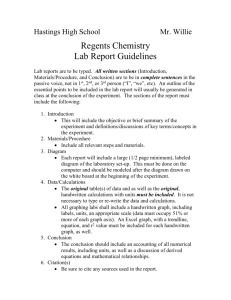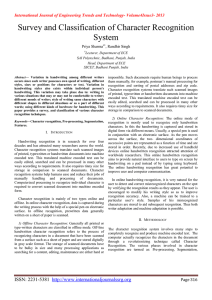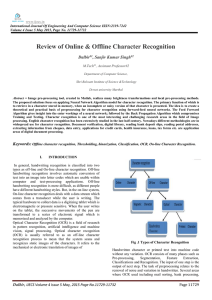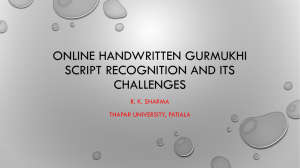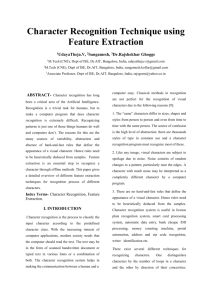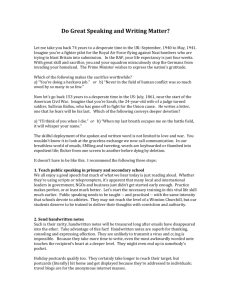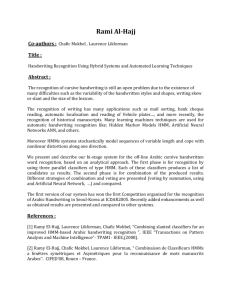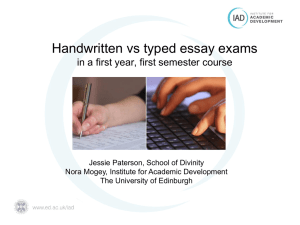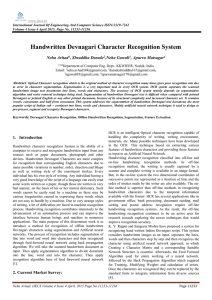Abstract
advertisement
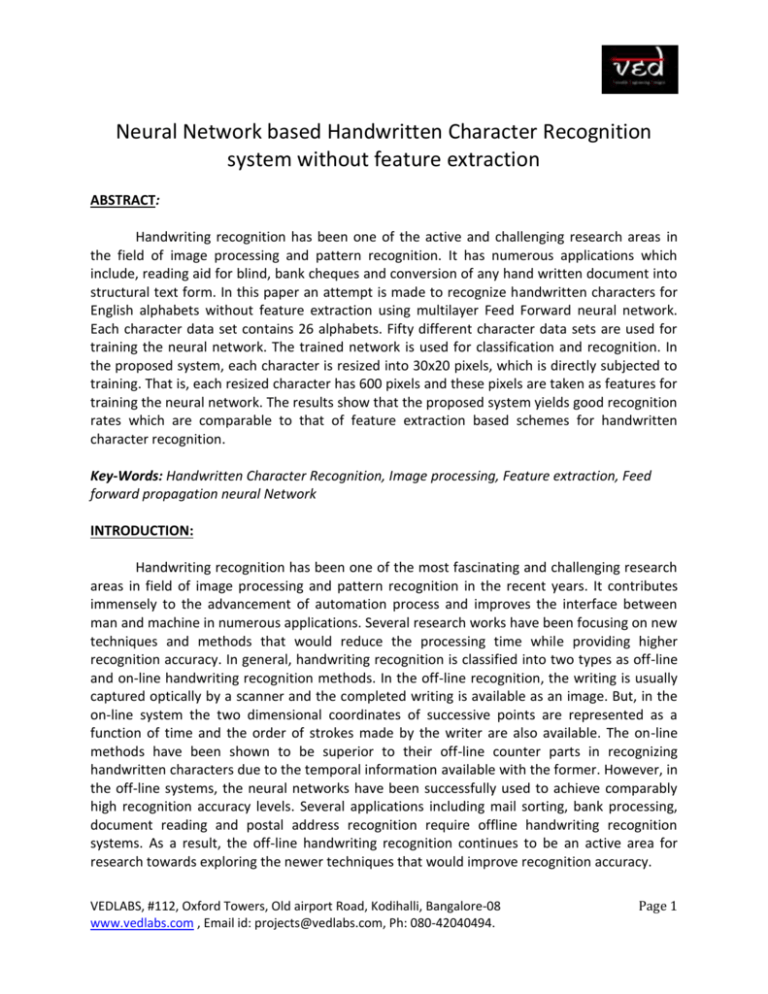
Neural Network based Handwritten Character Recognition system without feature extraction ABSTRACT: Handwriting recognition has been one of the active and challenging research areas in the field of image processing and pattern recognition. It has numerous applications which include, reading aid for blind, bank cheques and conversion of any hand written document into structural text form. In this paper an attempt is made to recognize handwritten characters for English alphabets without feature extraction using multilayer Feed Forward neural network. Each character data set contains 26 alphabets. Fifty different character data sets are used for training the neural network. The trained network is used for classification and recognition. In the proposed system, each character is resized into 30x20 pixels, which is directly subjected to training. That is, each resized character has 600 pixels and these pixels are taken as features for training the neural network. The results show that the proposed system yields good recognition rates which are comparable to that of feature extraction based schemes for handwritten character recognition. Key-Words: Handwritten Character Recognition, Image processing, Feature extraction, Feed forward propagation neural Network INTRODUCTION: Handwriting recognition has been one of the most fascinating and challenging research areas in field of image processing and pattern recognition in the recent years. It contributes immensely to the advancement of automation process and improves the interface between man and machine in numerous applications. Several research works have been focusing on new techniques and methods that would reduce the processing time while providing higher recognition accuracy. In general, handwriting recognition is classified into two types as off-line and on-line handwriting recognition methods. In the off-line recognition, the writing is usually captured optically by a scanner and the completed writing is available as an image. But, in the on-line system the two dimensional coordinates of successive points are represented as a function of time and the order of strokes made by the writer are also available. The on-line methods have been shown to be superior to their off-line counter parts in recognizing handwritten characters due to the temporal information available with the former. However, in the off-line systems, the neural networks have been successfully used to achieve comparably high recognition accuracy levels. Several applications including mail sorting, bank processing, document reading and postal address recognition require offline handwriting recognition systems. As a result, the off-line handwriting recognition continues to be an active area for research towards exploring the newer techniques that would improve recognition accuracy. VEDLABS, #112, Oxford Towers, Old airport Road, Kodihalli, Bangalore-08 www.vedlabs.com , Email id: projects@vedlabs.com, Ph: 080-42040494. Page 1 BLOCK DIAGRAM: Fig.1. Schematic diagram of the proposed off-line recognition system In this section, the proposed recognition system is described. A typical handwriting recognition system consists of pre-processing, segmentation, classification and post processing stages. The proposed method which does not include feature extraction stage is shown in Fig.1. A. Image acquisition In Image acquisition, the recognition system acquires a scanned image as an input image. The image should have a specific format such as JPEG, BMT etc. This image is acquired through a scanner, digital camera or any other suitable digital input device. B. Pre-processing The pre-processing is a series of operations performed on the scanned input image. It essentially enhances the image rendering it suitable for segmentation. The various tasks performed on the image in pre-processing stage are shown in Fig.2 Binarization process converts a gray scale image into a binary image using global thresholding technique. Dilation of edges in the binarized image is done using sobel technique, dilation the image and filling the holes present in it are the operations performed in the last two stages to produce the preprocessed image suitable for segmentation. VEDLABS, #112, Oxford Towers, Old airport Road, Kodihalli, Bangalore-08 www.vedlabs.com , Email id: projects@vedlabs.com, Ph: 080-42040494. Page 2 C. Segmentation In the segmentation stage, an image of sequence of characters is decomposed into sub-images of individual character. In the proposed system, the pre-processed input image is segmented into isolated characters by assigning a number to each character using a labeling process. This labeling provides information about number of characters in the image. Each individual character is uniformly resized into 30X20 pixels. Fig.2. Pre-processing of handwritten character of image D. Classification and Recognition The classification stage is the decision making part of the recognition system. A feed forward back propagation neural network is used in this work for classifying and recognizing the handwritten characters. The 600 pixels derived from the resized character in the segmentation stage form the input to the classifier. The neural classifier consists of two hidden layers besides an input layer and an output layer. The hidden layers use log sigmoid activation function and the output layer is a competitive layer as one of the characters is required to be identified at any point in time. The total number of neurons in the output layer is 26 as the proposed system is designed to recognize English alphabets. E. Post- processing VEDLABS, #112, Oxford Towers, Old airport Road, Kodihalli, Bangalore-08 www.vedlabs.com , Email id: projects@vedlabs.com, Ph: 080-42040494. Page 3 Post-processing stage is the final stage of the proposed recognition system. It prints the corresponding recognized characters in the structured text form by calculating equivalent ASCII value using recognition index of the test samples. HARDWARE AND SOFTWARE REQUIREMENTS: Software Requirement Specification: Operating System: Windows XP with SP2 Tool: MATLAB R2010, Version: 7.10.0 Hardware Requirement specification: Minimum Intel Pentium IV Processor Primary memory: 2 GB RAM, REFERENCES: [1] S. Mori, C.Y. Suen and K. Kamamoto, “Historical review of OCR research and development,” Proc. of IEEE, vol. 80, pp. 1029-1058, July 1992. [2] N. Arica and F. Yarman-Vural, “An Overview of Character Recognition Focused on Off-line Handwriting”, IEEE Transactions on Systems, Man, and Cybernetics, Part C: Applications and Reviews, Vol.31 (2), pp. 216 - 233. 2001. [3] V.K. Govindan and A.P. Shivaprasad, “Character Recognition – A review,” Pattern Recognition, Vol. 23, no. 7, pp. 671- 683, 1990. [4] R. Plamondon and S. N. Srihari, “On-line and off- line handwritten character recognition: A comprehensive survey,”IEEE. Transactions on Pattern Analysis and Machine Intelligence, Vol. 22, no. 1, pp. 63-84, 2000. [5] U. Bhattacharya, and B. B. Chaudhuri, “Handwritten numeral databases of Indian scripts and multistage recognition of mixed numerals,” IEEE Transaction on Pattern analysis and machine intelligence, Vol.31, No.3, pp.444-457, 2009. VEDLABS, #112, Oxford Towers, Old airport Road, Kodihalli, Bangalore-08 www.vedlabs.com , Email id: projects@vedlabs.com, Ph: 080-42040494. Page 4
